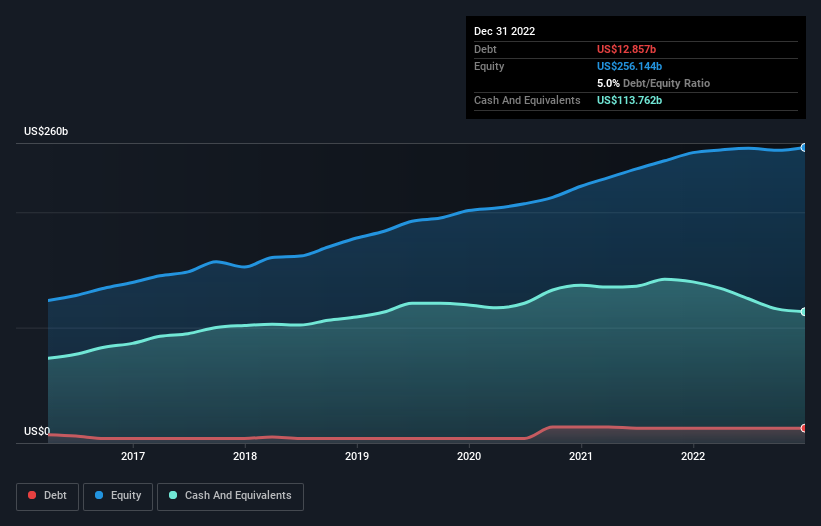David Iben put it well when he said, ‘Volatility is not a risk we care about. What we care about is avoiding the permanent loss of capital.’ It’s only natural to consider a company’s balance sheet when you examine how risky it is, since debt is often involved when a business collapses. We can see that Alphabet Inc. (NASDAQ:GOOGL) does use debt in its business. But is this debt a concern to shareholders?
What Risk Does Debt Bring?
Debt and other liabilities become risky for a business when it cannot easily fulfill those obligations, either with free cash flow or by raising capital at an attractive price. Ultimately, if the company can’t fulfill its legal obligations to repay debt, shareholders could walk away with nothing. However, a more frequent (but still costly) occurrence is where a company must issue shares at bargain-basement prices, permanently diluting shareholders, just to shore up its balance sheet. By replacing dilution, though, debt can be an extremely good tool for businesses that need capital to invest in growth at high rates of return. The first step when considering a company’s debt levels is to consider its cash and debt together.
View our latest analysis for Alphabet
What Is Alphabet’s Debt?
As you can see below, Alphabet had US$12.9b of debt, at December 2022, which is about the same as the year before. You can click the chart for greater detail. However, it does have US$113.8b in cash offsetting this, leading to net cash of US$100.9b.
How Strong Is Alphabet’s Balance Sheet?
We can see from the most recent balance sheet that Alphabet had liabilities of US$69.3b falling due within a year, and liabilities of US$39.8b due beyond that. On the other hand, it had cash of US$113.8b and US$40.3b worth of receivables due within a year. So it actually has US$44.9b more liquid assets than total liabilities.
This short term liquidity is a sign that Alphabet could probably pay off its debt with ease, as its balance sheet is far from stretched. Simply put, the fact that Alphabet has more cash than debt is arguably a good indication that it can manage its debt safely.
But the other side of the story is that Alphabet saw its EBIT decline by 4.9% over the last year. That sort of decline, if sustained, will obviously make debt harder to handle. There’s no doubt that we learn most about debt from the balance sheet. But it is future earnings, more than anything, that will determine Alphabet’s ability to maintain a healthy balance sheet going forward. So if you’re focused on the future you can check out this free report showing analyst profit forecasts.
Finally, a company can only pay off debt with cold hard cash, not accounting profits. While Alphabet has net cash on its balance sheet, it’s still worth taking a look at its ability to convert earnings before interest and tax (EBIT) to free cash flow, to help us understand how quickly it is building (or eroding) that cash balance. Over the last three years, Alphabet recorded free cash flow worth a fulsome 87% of its EBIT, which is stronger than we’d usually expect. That positions it well to pay down debt if desirable to do so.
Summing Up
While it is always sensible to investigate a company’s debt, in this case Alphabet has US$100.9b in net cash and a decent-looking balance sheet. The cherry on top was that in converted 87% of that EBIT to free cash flow, bringing in US$60b. So is Alphabet’s debt a risk? It doesn’t seem so to us. Over time, share prices tend to follow earnings per share, so if you’re interested in Alphabet, you may well want to click here to check an interactive graph of its earnings per share history.
If you’re interested in investing in businesses that can grow profits without the burden of debt, then check out this free list of growing businesses that have net cash on the balance sheet.
Have feedback on this article? Concerned about the content? Get in touch with us directly. Alternatively, email editorial-team (at) simplywallst.com.
This article by Simply Wall St is general in nature. We provide commentary based on historical data and analyst forecasts only using an unbiased methodology and our articles are not intended to be financial advice. It does not constitute a recommendation to buy or sell any stock, and does not take account of your objectives, or your financial situation. We aim to bring you long-term focused analysis driven by fundamental data. Note that our analysis may not factor in the latest price-sensitive company announcements or qualitative material. Simply Wall St has no position in any stocks mentioned.
Join A Paid User Research Session
You’ll receive a US$30 Amazon Gift card for 1 hour of your time while helping us build better investing tools for the individual investors like yourself. Sign up here










